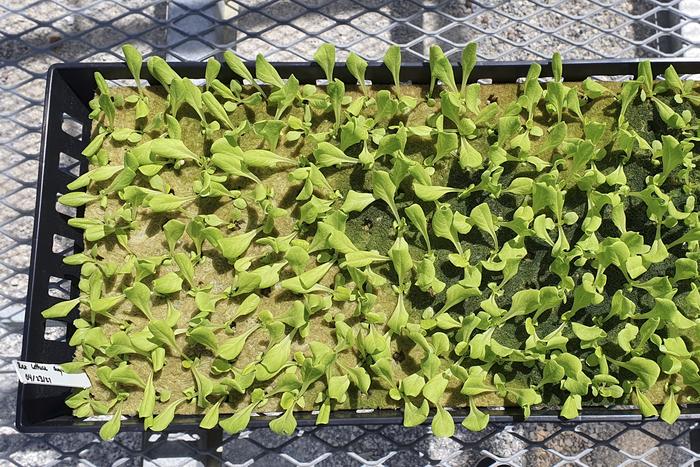FAYETTEVILLE, Ark. — As controlled environment agriculture and vertical farming gain a greater foothold in modern agriculture, a new $300,000 grant aims to enhance hydroponic lettuce production.
FAYETTEVILLE, Ark. — As controlled environment agriculture and vertical farming gain a greater foothold in modern agriculture, a new $300,000 grant aims to enhance hydroponic lettuce production.
Kristen Gibson, director of the Arkansas Center for Food Safety and Arkansas Agricultural Experiment Station faculty member, is the lead researcher on the grant from the U.S. Department of Agriculture’s National Institute of Food and Agriculture. Gibson says the grant provides an opportunity to meet the needs of the hydroponics industry.
“The industry is always looking for what’s going to help them grow the best product, increase profit and not cause disease,” Gibson said.
The funding comes at a time when U.S. hydroponic production of lettuce is growing. According to a January 2024 report by the USDA, hydroponic lettuce production more than doubled over five years, from 15.4 million pounds in 2014 to 36.4 million pounds in 2019. This rapid growth calls for a greater understanding of plant pathogens and food safety risks in these systems, Gibson said.
“It’s a growing industry,” Gibson said. “They are asking for solutions, and we’re trying to help provide them with some guidance on what we know.”
The focus of the research will be to evaluate soilless substrates as a critical point for controlling pests and pathogens, Gibson said. Soilless substrates serve the same function as soil in traditional agricultural systems, physically supporting the plant and acting as a medium to deliver oxygen, nutrients and water to plant roots. Some common examples of soilless substrates include volcanic rock, coconut coir, sand, perlite and vermiculite. Soilless substrates, in general, represent some of the most promising points for growers to apply an intervention to prevent pests and pathogens, Gibson said.
“They want to see what’s out there — what can be validated — because soilless substrates are often considered a point where some of these plant pathogens could be introduced,” she said.
Gibson noted the research will not only address pathogens that make people sick but also pathogens and pests that make the plants sick.
“If we combine strategies where you’re addressing plant pathogens at the same time as food safety, it works better,” she said.
Co-principal investigators on the project include Rupesh Kariyat, associate professor of insect-plant interactions and chemical ecology in the entomology and plant pathology department; and Ryan Dickson, assistant professor of greenhouse and controlled-environment agriculture in the horticulture department. Gibson, Kariyat and Dickson conduct research for the Arkansas Agricultural Experiment Station, the research arm of the University of Arkansas System Division of Agriculture.
Roadmap for safer hydroponic production
Gibson said the first objective of the project is to establish the impact of soilless substrates on pathogen and pest risk. Using a controlled greenhouse environment, the research team will assess how foodborne pathogens and plant pests persist in different kinds of substrates.
“The first part is to look at a lot of the substrates that are available on the market,” Gibson said. “We want to figure out which ones are actually aiding in the proliferation or the persistence of plant pathogens, plant pests, or human pathogens of concern.”
For the project’s second objective, the researchers will test the ability of different biopesticides — or non-synthetic pesticides — to control pests and pathogens in different substrates. A key part of this step, Gibson said, is to consider the scale of commercial operations.
“We can do application on a small scale, but when you think about a commercial scale, you want to figure out what’s going to make this feasible for growers,” she said.
The final objective of the project is to translate the research findings from the first two objectives into best practices for hydroponic lettuce growers. Gibson said the team will develop a set of comprehensive training materials for growers through extension activities, including workshops and training sessions with producers.
This grant is part of the Agriculture and Food Research Initiative’s Critical Agriculture Research and Extension program, from USDA-NIFA. The project award number is 2024-68008-42637.
To learn more about Division of Agriculture research, visit the Arkansas Agricultural Experiment Station website. Follow us on X at @ArkAgResearch, subscribe to the Food, Farms and Forests podcast and sign up for our monthly newsletter, the Arkansas Agricultural Research Report. To learn more about the Division of Agriculture, visit uada.edu. Follow us on X at @AgInArk. To learn about extension programs in Arkansas, contact your local Cooperative Extension Service agent or visit uaex.uada.edu.
About the Division of Agriculture
The University of Arkansas System Division of Agriculture’s mission is to strengthen agriculture, communities, and families by connecting trusted research to the adoption of best practices.
Through the Agricultural Experiment Station and the Cooperative Extension Service, the Division of Agriculture conducts research and extension work within the nation’s historic land grant education system.
The Division of Agriculture is one of 20 entities within the University of Arkansas System. It has offices in all 75 counties in Arkansas and faculty on five system campuses.
The University of Arkansas System Division of Agriculture offers all its Extension and Research programs and services without regard to race, color, sex, gender identity, sexual orientation, national origin, religion, age, disability, marital or veteran status, genetic information, or any other legally protected status, and is an Affirmative Action/Equal Opportunity Employer.
# # #





